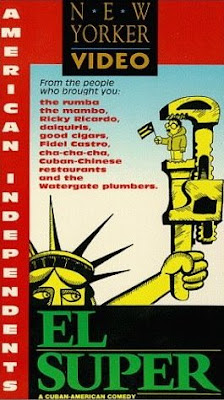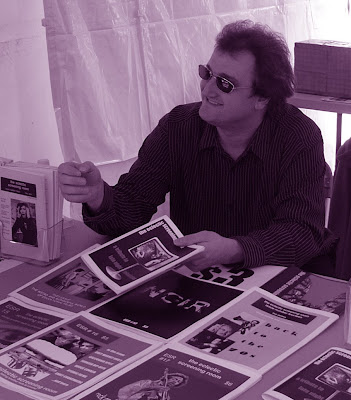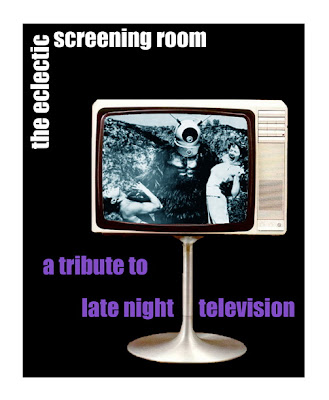
Last weekend I attended a retrospective of Jack Smith films at Pleasuredome. This collective has been screening independent-experimental works for almost two decades now, and sadly this is a venue I don't attend enough. (They usually screen Saturday nights when it is the least easy for me to get out.) It was P-Dome who in the 1990's held the Toronto premiere of Jack Smith's infamous 1963
Flaming Creatures, which had long been suppressed by censors. (To my knowledge, a ban imposed upon the film in the state of Massachusetts during the 1960's has never been lifted.)
Shot on a rooftop in one afternoon, Smith's 43-minute opus is basically the exclamation point of most of his cinema, as a Bowery-level valentine to Maria Montez and her exotic pictures for Universal in the 1940's. Jack Smith's films largely attempt to evoke a dime-store-level exotica with underground superstars in thrift-store costumes striking histrionic poses while the soundtrack is typically filled with tinny scratchy 78 rpms, further lending itself to the antiquity and otherworldliness.
Flaming Creatures however was a taboo film in its day for its onscreen genitalia (male and female), and while today it is hard to get offended over seeing flaccid penises and sagging breasts, certainly this movie won him some notoriety, and arguably, remains his last work in any form of completion. His subsequent works, including the magnum opus
Normal Love, remained in tatters, largely because he would continue to chop up his films into segments for live performances where he would score the movies on the spot with the crates of records he would cart along.
After he died in 1989, his works remained in such tatters, and his archivist Jerry Tartaglia would carefully reconstruct them to Smith's initial intent. To be sure, Jack Smith was one of the most colourful and unique figures in all of cinema, but I confess to getting bored really fast by his films, which are frustrating to sit through, and even more once considers that Smith intended to irritate us. However, since getting the chance to see any work of Jack Smith, let alone on a big screen, is about as rare as seeing a decent performance by Julia Roberts, and because I am always willing to be proven otherwise, I raced down to see the collection of pictures that were presented by Tartaglia.
It was surely a novel setting- where Smith's tinny exotica unspooled in the courtyard of 401 Richmond while the stars shone above (and mosquitoes attacked full force). Seeing the dull gaze of the movie screen reflect upon the winding staircase also evokes an otherworldly feeling, befitting that of what is on screen. And despite that Smith succeeds in creating a unique atmosphere on film, even more impressive in that he does it with scraps, this screening still didn't change my mind about Jack Smith. I find his work not so much dull as infuriatingly uneven- and even more that these films were indirectly designed that way.
And it isn't really that you watch Smith for any kind of storytelling, but there is seldom any structure, and truthfully little of interest happens on screen as watching a bunch of people lying around in sarongs gets tiresome really fast. The collection
Jack Smith Super8 Films, made circa 1975-1985 at first has some pretense of narrative despite that what we're seeing is edited-in-camera reels, with some pretty good lobster monster, and then the movie shifts to endless shots of litter.
Sinbad of Baghdad, shot on Super8 in 1978, is impressive for its exotic look, where Smith makes a costume epic on the beach of Coney Island, but is formless.
I Was a Male Yvonne DeCarlo, completed in 1970, features Smith himself, as does
Song for Rent (1968-9), with Smith playing his alter ego Rose Courtyard, while Kate Smith's "God Bless America" is on the soundtrack. At least
DeCarlo has some attempt at structure as it is bookended by shots of a wrecking ball demolishing an old theater. In this regard, the film is a testament about the end of the kind of cinema that Jack Smith holds dear. In fact, this and
Sinbad are interesting for the way in which his manufactured worlds are in conflict with the real world. The wrecking ball invades the fragile landscape Smith likes to preserve, and alternately, the actors of
Sinbad run through the crowds of Coney Island while in their movie garb, as bemused spectators look on.
When Smith died in 1989, (I am paraphrasing from Tartaglia in the Q&A), not only was his estate a mess, but so was his body of work (and all the more saddening is that he made it so for people to sort out). Kudos to Tartaglia for carefully restoring and re-assembling his work as best as he could to their original glory. But the more work I see of Smith's, the more I realize that his interesting, colourful personality supercedes his work. He sure knows how to set an atmosphere, but ultimately, of the seven or eight films I've seen to date, I have yet to see a Jack Smith film that is consistently interesting. If we were to compare his work even with those of his contemporaries in the so-called Baudelarian cinema of the early 1960's, that made heartfelt valentines to trash, it is neither as clever or fun as the Kuchar brothers' and not as challenging or weirdly beautiful as that of Ron Rice. But for all that, because Smith's personality is surely one of the most unique and interesting in all of cinema, if someone dug out a print of
No President or
Wino for a screening tomorrow, I would nonetheless run down to see it. And even if I once again walked away disappointed, well in some way Jack Smith has succeeded. He has created an aura about himself that will continue to draw people in, still attempting to figure him out.
Postscript:
The evening ended with a long Q&A session, with much of it devoted to Tartaglia's first-hand account of the troubles with Mary Jordan and her documentary on Smith. When someone asked him about it, he replied "Well it doesn't take long for people to get to the bad stuff, doesn't it?". But he was practically inviting the audience to ask him about it, as he carefully hinted at such things in his introduction. Suffice to say, there were legal problems resulting with not only Smith's estranged sister (who initially wanted his stuff destroyed after his death, only then to sue for royalties when she realized it had some artistic worth), but with Mary Jordan, who was suing Tartaglia and others who knew Jack Smith, from withholding materials which were essential for her to complete her documentary
Jack Smith and the Destruction of Atlantis.
All of these legal issues have been resolved, but understandably the bitterness remains, as Tartaglia peppered his monologues about Mary Jordan, largely painting her as a giddy outsider who knew nothing about Jack, and after all her invading old ghosts, his testament was that she still ended up with a skin-deep documentary that still doesn't scratch the surface of his work. And twice did he make allusions to the fact that she used a clip from one of tonight's films, but criticized her for not using the music that accompanied it. Well, I can't remember this scene in Jordan's documentary (which by the way I liked very much), let alone in what context she used it. Ultimately, it is obviously Tartaglia who received the short end of the stick in these matters, as his years spent preserving Smith's work, didn't necessarily line his pockets with silver, and so I can understand his frustration, but I sense another argument underneath all this.
When I saw Jordan's documentary in Toronto last year, the place was packed with many more spectators than those who saw Jack Smith here in person in 1984, and, let's face it, more than who came out to see tonight's films. If anything, I detect a lot of resentment from Smith's inner circle that this outsider has made a commercially digestible documentary, which ironically made a pop portrait of an artist who resisted commerce, and certainly whose work was not digestible for the mainstream. But in truth, I don't think she changed anyone's mind about Smith, but perhaps introduced his work to many more people that otherwise wouldn't have experienced it if they weren't among the few who had seen it in small group venues such as this. What's wrong with that? I don't think it's sacrilegious to make a large populace aware of one's work. Commerce will not taint Jack Smith-- no one is going to be running around in a "Flaming Creatures" T-shirt (as cool as that might be), and Smith's films will still be relegated to the exaltations of the privileged few in small cine-clubs. If anything, she positively nailed the dichotomy of Smith's personality and work-- and ultimately the controversy surrounding her film made the movie another example of the difficult issues surrounding Smith's work. Somewhere in neverneverland, Jack Smith is rejoicing at yet another mess.






























